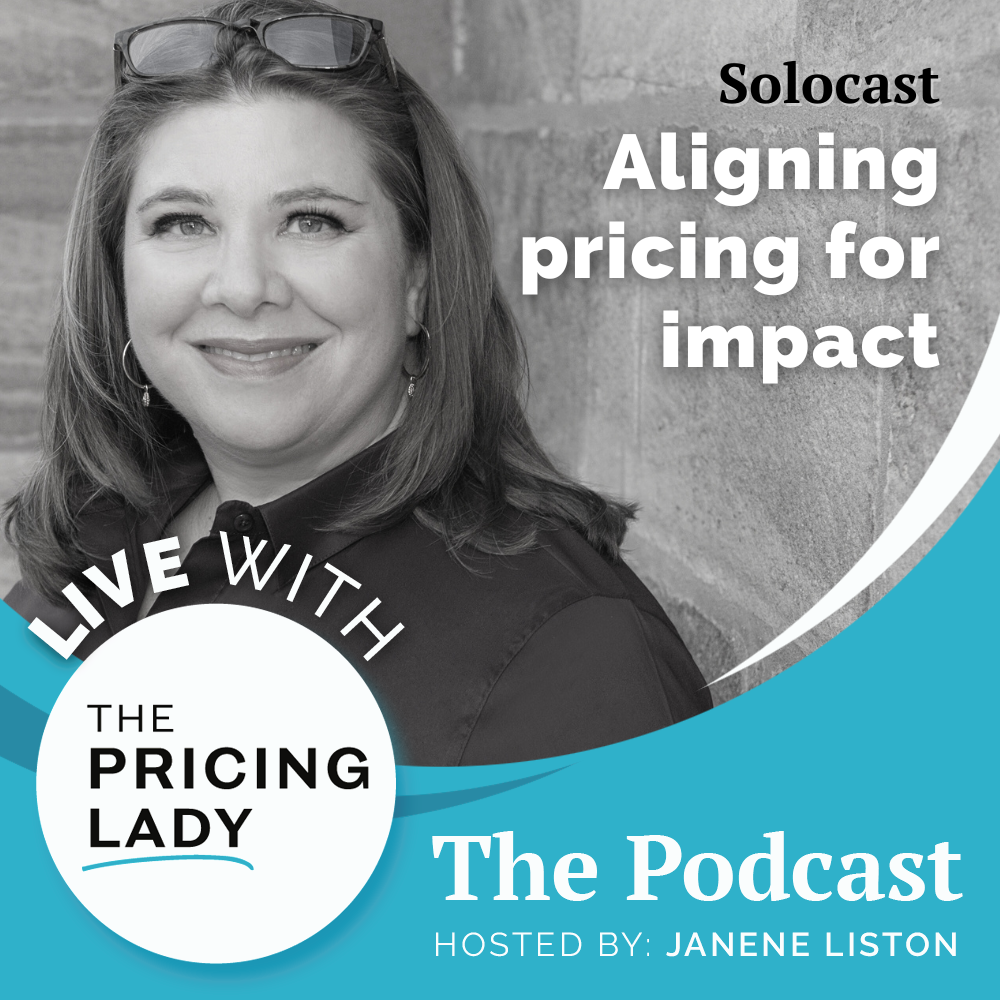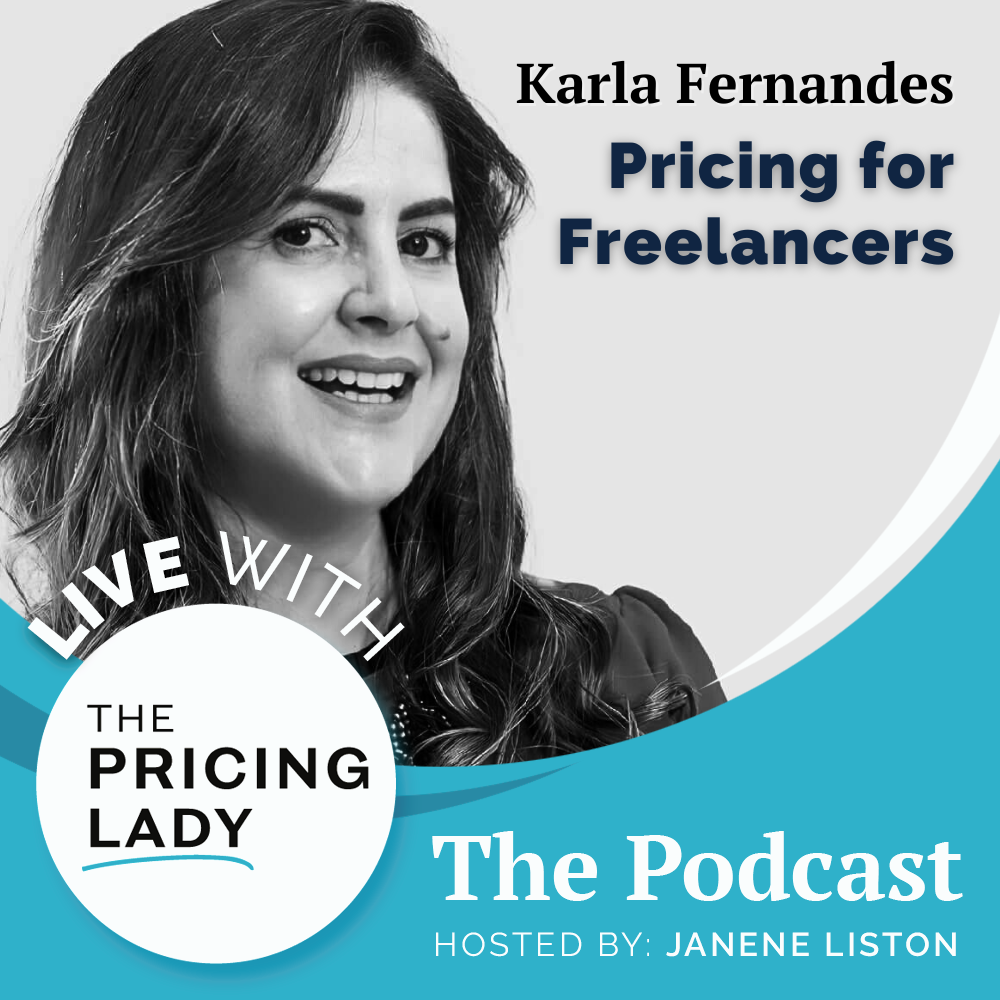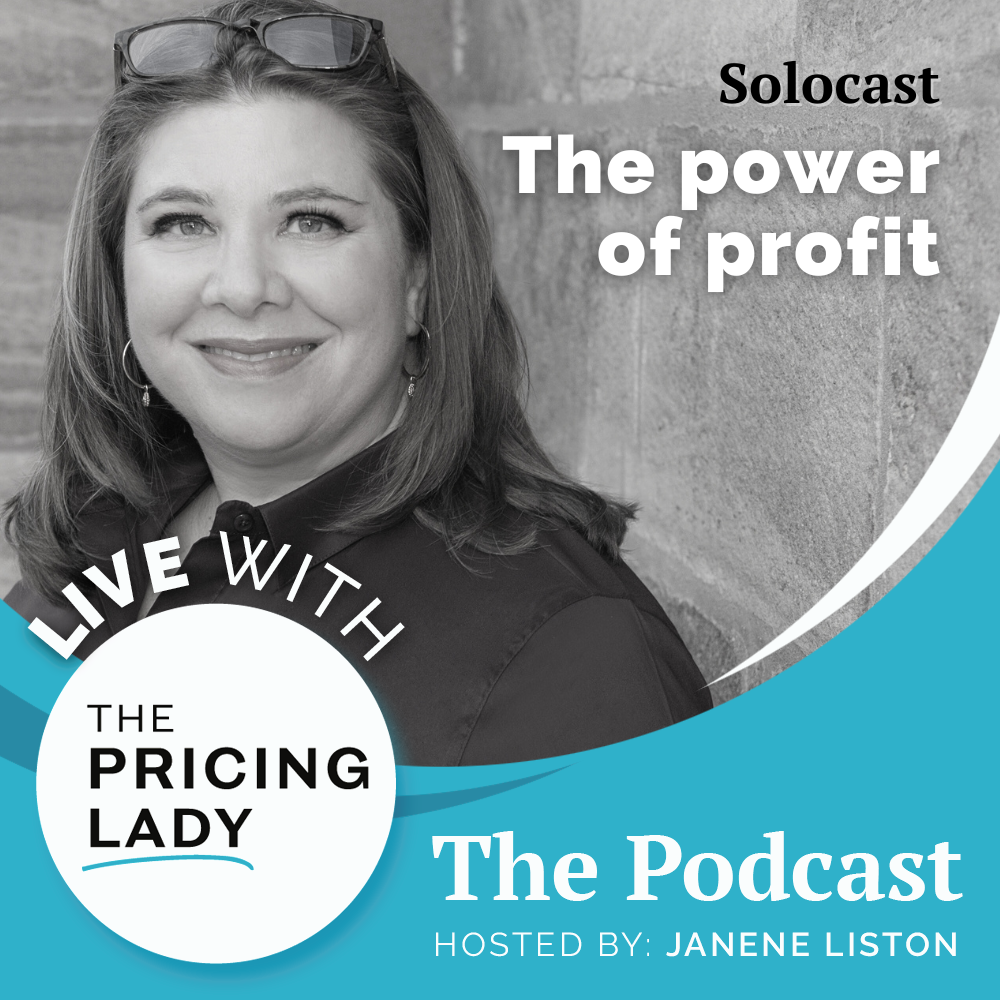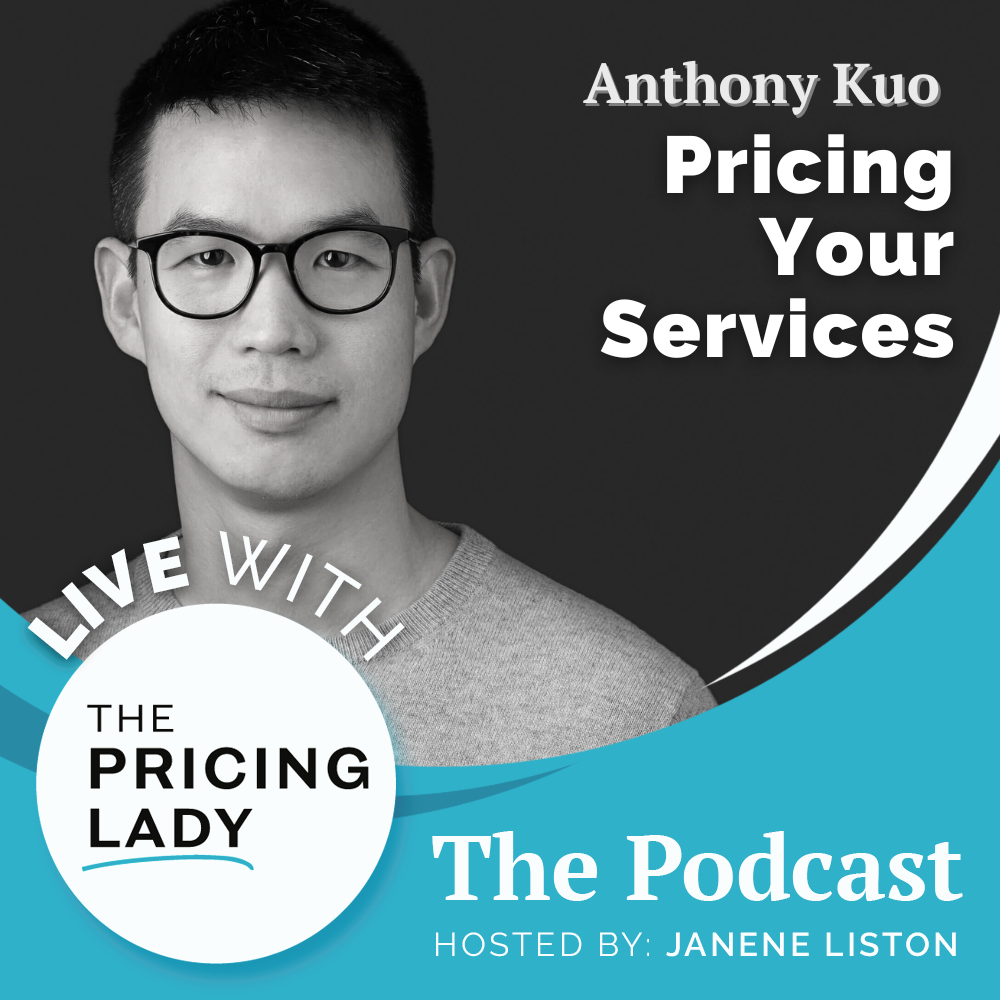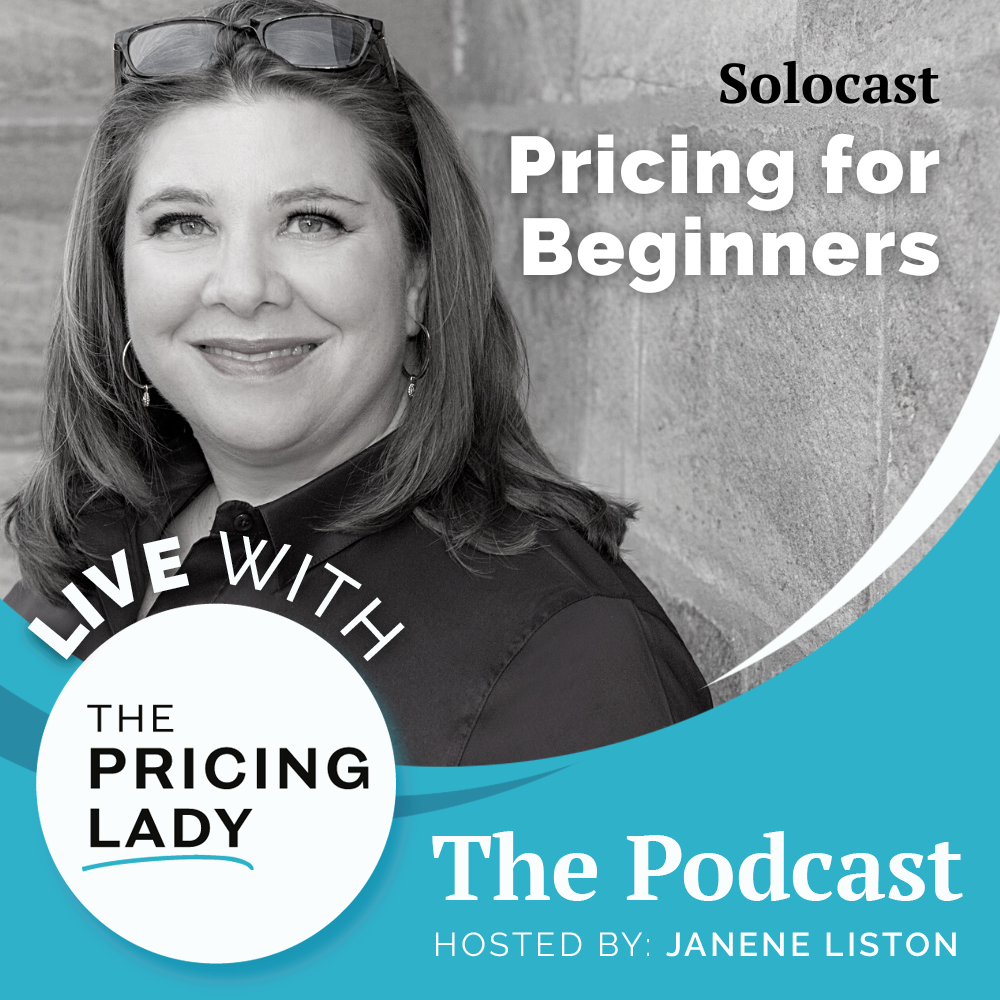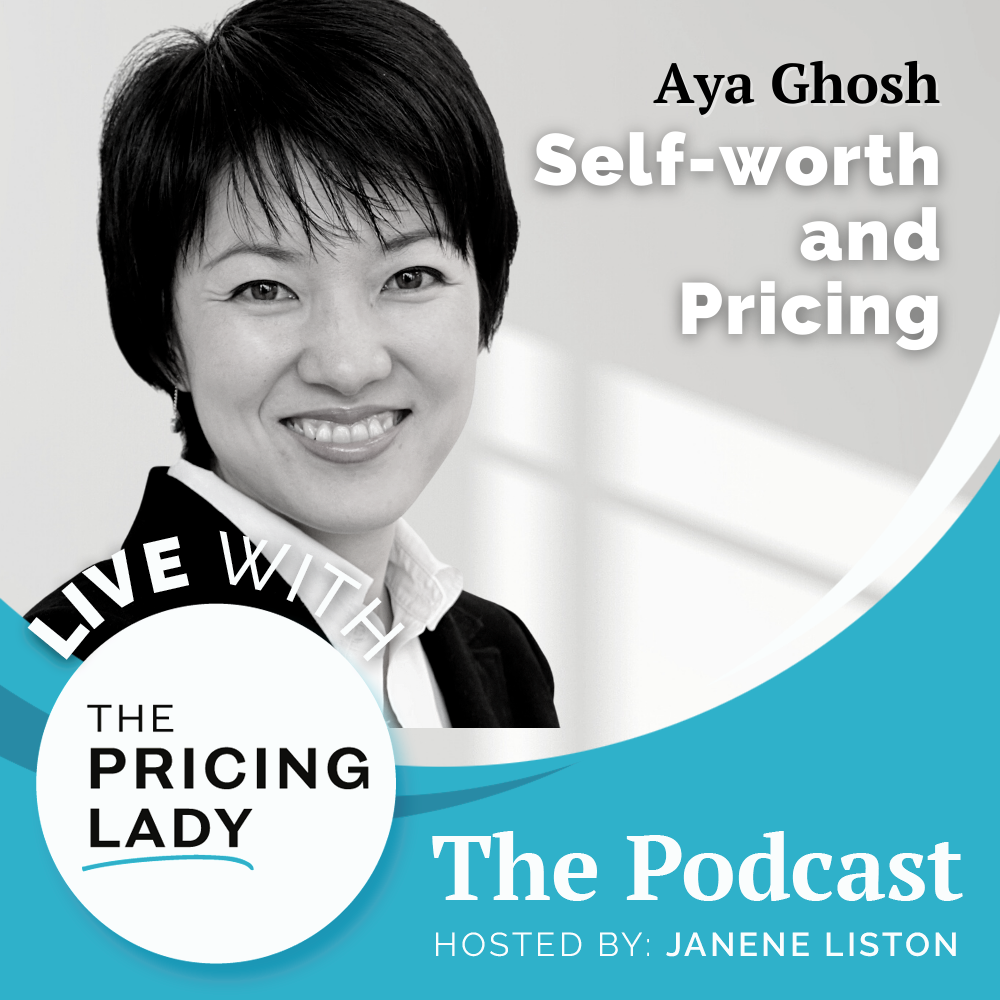Pricing behavior is fascinating and it is influenced by many things – like geography, culture, upbringing, industry etc.
We can learn so much by simply observing the world around us. Many years ago I was in Egypt at one of the markets and there was a stall with at least a dozen signs that read things like “hassle free pricing” and “hassle 10% extra”. It was also in multiple languages. I still have the photo too.
Now if you’ve been to a market in Egypt you know haggling is part of the process… it’s a natural pricing behavior in many parts of the world. This vendor was making a clear statement about his brand and customer experience people could expect. Also his sense of humor. It affected his pricing behavior and that of potential customers as well.
If you prefer to watch the live stream video replay, use this link.
In this episode…
In this episode of Live with the Pricing Lady, I’ve got special guest Sophia Syed. She’s the founder of Also Sophia Ltd. and Boss It Club. Also Sophia focuses on helping break down barriers. They supply ethnic celebration products for minorities within North America and Europe and have been picked up by Walmart. She’s fascinated by how different people, cultures and geographies relate to pricing…even the process that’s involved. She’ll share her own pricing journey. We’ll discuss what she’s observed, and how that’s played in her pricing behavior and what you should consider in your business.
Let’s take a book at how culture, geography and even your upbringing influences you and your customers’ pricing behavior.
Highlights of this episode:
0:00 Introduction
1:43 Who’s Sophia
6:52 Pricing early on
8:09 Customer first
9:51 Pricing behavior
14:16 The Relationship is center stage
18:24 The “price” shoppers
19:33 Message from the episode
Favorite quotes from this episode:
“…if you’re going to be selling to a target group where bargaining is part of the deal, then you want to have considered that in your pricing.” Janene
“As a small business, you should know inherently not only who your customer is, but where are you going to be selling.” Sophia Noreen
“I think that a lot of times the cultures where the selling process is a more relationship-based you have more bargaining going on as opposed to when it’s just a transaction that’s happening.” Janene
“It goes into the irresistible offer. The whole aspect of that irresistible offer is not just the product that they’re getting, but the whole experience of purchasing something from you. Sophia Noreen
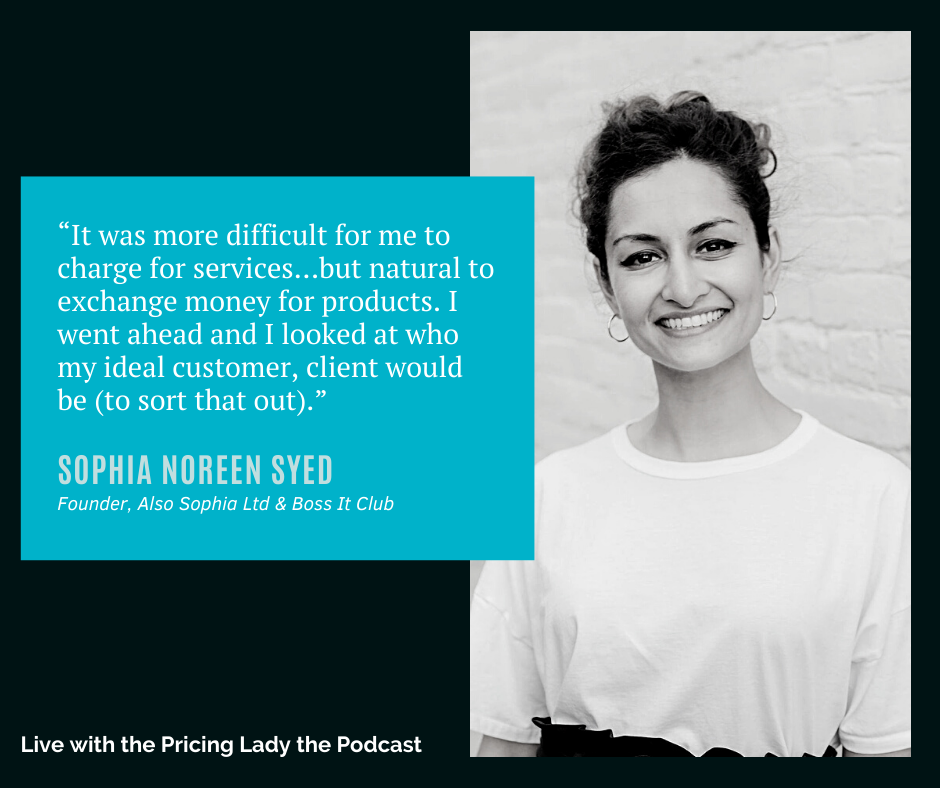
Links from this episode:
- Find Sophia at either Also Sophia Ltd or at BossIt Club
- Follow or connect with Sophia Noreen on
Connect with Janene
Website | Linkedin | YouTube | Facebook | Email List
Get started improving your business. Sometimes it’s difficult to know where to begin. I suggest you Download the the self assessment Pricing Scorecard. Get a view of what’s working and what’s not working when it comes to pricing in your business. Figure out where to start making improvements.
Get in touch with Janene. If you’ve got a question that needs answering, a challenge you’re facing or you have suggestions for future topics or guests, let me know. Contact Janene.
Listen up! Don’t miss out. There’s a lot going on and you’ll want to be in the know. Follow my YouTube channel (rate it too please) so you don’t miss an episode of Live with the Pricing Lady or join my Email List.
Transform your business and life. My business is about helping you build a better business. One that’s profitable and where you can confidently charge for the value you deliver. Let’s see how we can work together. Book a complimentary Discovery Call today!
Episode Transcript
(Note: this transcript has been edited)
Now, Sophia, why don’t we get started? And you could share with us first a bit about yourself.
The beginning of Also Sophia Ltd
Sophia: I’m a mom and I have two young girls. One of which is gone to school for the first time in almost a year, just for end of year school you know, a handoff to the next grade and then is here at home.
Started a product based business basically filling a need that was a culture gap in North America. We celebrate Eid or Ramadan, which are Muslim festivities. Unfortunately we didn’t have any of the products on the shelf like you would see for Christmas, Halloween and Easter. Because I grew up in Canada and the girls are growing up in Canada, I really wanted them to have the opportunity to also have these festive decorations.
It’s easy to make them, but at the end of the day a busy mom like myself,… I trained as a physiotherapist I didn’t have the ability to always DIY my product. I decided let’s, let’s wholesale them. Let’s create them and then let’s see if we can get it on the shelf [00:02:00] at a big store, like a Walmart.
The reason why is because I wanted it to be accessible to everybody, I didn’t want it to just be those individuals who could afford, no offense to ETSY, but at ETSY, is of course it’s a premium market because everyone is hand-making. Which is great.
It’s something that I support. I wanted to continue supporting. We do have some products on there as well, but the, at the end of the day, not everyone can afford an Etsy product. Right. That’s how we decided to pivot.
Janene: The business that you’ve been telling us about is called Also Sophia, correct?.
Sophia: Yes. The product based business is also Sophia and yeah, it grew very quickly in the middle of COVID.
Culture affects pricing behavior
That is I guess, where I started realizing that intersection between pricing and culture and geography.
And I know that’s one of our big topics for the day. Being south Asian and, and opening with your story about the conversation or the signage you saw the 10% extra for it hassle-free.
Janene: Hassle-free price.
Sophia: Right, right. Because it’s the culture. And I think it’s so incredible that even myself being south Asian, I realize it is part of the culture. Different cultures have different aspects of pricing. Sometimes part of the journey of purchasing is the offering. Right? So. It’s hard to shake that cultural act even when you come to America. So one of the things I found with my products was if I was in a location, like a flea market location, that’s where I started because that’s where I wanted to see if the product had any merit.
Location impact pricing behavior
We started off with money envelopes and balloons and banners, very simple, small things, and people were haggling. I actually said to one lady, listen, a dollar for you shouldn’t be a big deal. I said we do not bargain at this table because it’s such a small amount of money. But it’s built into the culture. I just think it’s fascinating. Really.
They were, there were women and men, of course, they saw that this small business that only sells about eight to 12 weeks a year had made it into Walmart, Canada, and they started asking questions. Right. They’re like, how did he do that? What did you do? How do you manufacture? Oh, the question. And I want to use the Also Sophia product based platform to go in with information, I wanted to be able to say, if you’re an entrepreneur, you’re budding entrepreneur, if you want to start something, feel free to come and look at BossIt Club, we have a website [00:05:00] bossitclub.com.
Basically that is meant for the entrepreneur. To give some communication and a there’s a podcast. So, yeah. So that’s the second half of this entrepreneurial business, I suppose.
Pricing at the beginning
Janene: Okay. Excellent. Let me first ask you… I always like to find out where people started the first time you had to sit down and set a price for something in your business. What was life like for you?
Sophia: Oh man. So. It’s difficult for me because I’m a trained physiotherapist or physical therapist and I work in public sector, so me and pricing were like on two different worlds. Right? Cause I never had to collect a dime from my patients or my clients. Right. They would either oHIP, which is our public funded system in Canada. And I didn’t have to put a dollar amount on my hours. So I know in consulting, or if you’re working for a firm, you have to cost yourself out. I always hear my husband and my brother-in-law. All of them are used to that. When it came to pricing, it was difficult.
It’s more difficult for me to charge for any services associated with BossIt club. I can’t, I just can’t do it. I have a mental block, but what I did for the products, because it’s, it’s more It’s not acceptable for me, but natural to exchange money for products was that.
Focus on the customers to shift your pricing behavior
I went ahead and I looked at who my ideal customer client would be. And I already did the average client or customer of Walmart, Canada. Now it’s a little bit in Canada because we don’t have a, a target, whatever the equivalent is in Europe. All of our target and Walmarts are all, all the customers are sitting in Walmart. Right. So, yeah, I look at that customer. I looked at a product that was similar. I would try to be competitive. And I would say, I want to make sure that the average Walmart customer can afford this product.
Janene: Right.
Sophia: That’s how I started. I went and I did the market research really is what it was all about and then making sure I tailored the price point to the client that I was serving. I think that helped. Right. When the Walmart guy came knocking, it wasn’t like, oh my gosh, this is too high of a price pointThey were like, oh, this fits within our price guarantee. And at the same time we’re making the margins because that’s a big thing for them. They need to make them.
Janene: Yeah, absolutely. Now, what I really loved about that is that you started with the customer and I always tell people, pricing is rooted in a deep understanding of the customer.
And in this case you had two. You had your end customer, but you also had Walmart, or other vendors also as customers as well. And that makes, that makes a difference because they think differently and you have to look at each one from, from a different perspective.
Noticing the cultural differences
That’s fantastic. Let’s talk a bit about this culture and geography. You were talking about some of your travels and some of the things that you’ve observed and experienced. How has that influenced what you do?
Sophia: Yeah, it’s a really great question. So when we chatted previously, we spoke [00:08:00] about how I traveled, of course to India. I have not been to the middle east, surprisingly and I haven’t been to Africa. Over there (Asia) the bartering system, negotiation, when it comes to price point is acceptable. I find that it is part of the culture. And so they know that, and that’s why I found that sign to be so hilarious. You know, it’s just great. It’s such a, such a humorous thing for me. And then of course, when we come over to a European country or north American country, it may not be acceptable in certain environments.
So for example, I’m not going to go into a retailer like Walmart and go barter with the cashier. Cause she’s gonna like excuse me like this is not my store, right? Yeah.
Janene: You’re holding up the line. Ma’am
Sophia: Security…person is confused. It’s interesting. In certain environments in North America and Europe we will have it be acceptable to have a bartering system. As [00:09:00] a small business, you should know inherently not only who your customer is, but where are you going to be selling.
If you’re going to a flea market, it could still be acceptable, right? You’re not in an environment where you’re bar coded, right? You’re in this very freestyle environment. Or if you’re at a craft store or a farmer’s market, you may have a similar situation with a similar group of people.
Sometimes it’s just not acceptable, it’s offensive.
Now I went to China and Japan on vacation. And it’s not really acceptable to barter in Japan. It’s almost like an insult because you’re seeing them on what they have valued their product. And if you think of it as a small business, you. Putting your, your blood, your sweat, and your blood, your time, your energy into the product.
Now somebody coming and saying, well, I think you are not valid. They take it really personally, somehow we still managed to barter with one of the merchants there only because we were buying like 20 shirts or something. And my husband wanted an action figure. No, don’t ask, but as well. So I thought it was funny because we still managed in some ways to barter. But.
I work with a lot of Asian countries, to manufacturer. I know inherently that I can’t be too, like I will ask, you know, and they obviously know they for ordering a large quantity that they have to be forgiving on the price. So then, you know, everybody’s winning. But knowing that I would not be as aggressive as if, as if I was bartering with somebody in say India.
And the reason why is because they have already counted for bartering in their price tag. Yeah. Right. They’ve already increased.
Adjusting your prices & pricing behavior
Janene:And that’s a, that’s an important part point because if you’re going to be selling to a target group where bargaining is part of the deal, then you want to have considered that in your pricing.
One thing that I discuss with clients all the time is, you know, understanding where your walkaway point is and what are the points between where your first prices and the walkaway price. And, how are you going to handle, you know, those levels and what exchange value you’re going to give? When I worked in the corporate world one of the first places I ever went to do a negotiation was China, and it was not easy. They are very tough negotiators.
Sophia: I think you need to make friends if you can. That’s what I found. I think they go the extra mile if they really like you, if they, if they’re kind of like, whatever… sorry is not working for us. But yeah.
Relationship versus transaction
Janene: It’s very relationship-based. I think that a lot of times the cultures where the selling process is a little bit more relationship-based you have, maybe I’m overstretching this here, a bit more bargaining going on as opposed to when it’s just a transaction that’s happening. And that could be one indicator there. And I also think that, you know, different cultures. It’s not just culture, it’s even different families.
You’re raised in different ways. I don’t remember my parents doing a lot of haggling unless they were buying a car.
Sophia:There you go. Right. And there’s also margin in a car right there versus maybe other things and even similarly a house. Right. If you think about it, it’s acceptable in the north American culture. And I imagine Europe is similar. You correct me if I’m wrong because I’ve never bought a house. Yeah.
Janene: Yes it is.
It’s an energy exchange
Sophia: Because the price tag allows for a little bit of negotiation because it is thousands and thousands of dollars, I think worth the, it’s almost like an energy exchange. Right? So it’s worth it. The energy exchange to say, okay, well, I can’t manage $10,000 more for this house.
Is there a way for you, right? Because it’s worth the energy saving, but then, you know, contrasting that with my, a flea market slash a small vending event to sell my money envelope. And the lady was arguing for a dollar. I looked at her I’m like, lady you arguing with me is not worth my energy exchange. Like the dollar is not going to affect you or me. So why are you having this conversation? You know?
And I was like, anything but Curry, I just needed one day break. Just one just one meal.
So he took us to like a Domino’s pizza. I think they have Domino’s or the equivalent there, and I was really hungry. So the waiter came over and I was like, I’ll have it. And he goes, no, no, no. I have to negotiate the price of a Pepsi and put pizza first.
Preparation is key to having suitable ways of working
I’m just hungry. Yeah, it really, it really is different. It really is different. The point here for those of you who are listening, is that depending on who you’re targeting, it’s important to keep these things in mind. Does that mean that if you’re selling a certain product or service into any customer group in the country that does a lot of haggling that you have to haggle?
Not necessarily, but it means that you should think about when and if there are times and how you’re going to handle that, because the preparation is absolutely key.
Sophia: Exactly. And you know, you don’t have to, like you said, I think. We have especially in North America, moving the cultural norm towards saying, this is the price.
I think many will have accepted that I don’t have many hagglers or bargainers that come forward anymore. Even if I go with a small bending event, I don’t go to [00:15:00] too many. I usually go to one a year and they don’t haggle any more. They, really just say, okay, this is the price, but that’s probably because the people who are shopping at my particular business, are of my I to say age group, but like, right.
They’ve been brought up and born in Canada and they know that it takes a lot of effort to get a business off the ground. By supporting a small business, then, you know, you’re, you’re supporting the community. That is the common language I found. Now, when I go to the small bunny, I do still have customers that are like, I want to discount or I’m waiting for a discount and you’re always, I’m gonna have that.
The Price Shoppers will be there
You’re always going to have the price shoppers. If you want to incorporate that into your business, you definitely have, when you’re doing your pricing your price analysis or checking your margins, just note for a reduction right in your margin. If you are going to have to put things on sale to attract that specific Buyer. But you don’t have to.
Janene: Thank you.
Sophia: Right.
Janene: Yes. Thank you so much for bringing that up because I think that’s a point. [00:16:00] No, I don’t think I know. I see it all the time with people or I asked them, what do you sell it for? Oh, I sell it for 75 francs or $75. Then we dig into it and you can see that that was the exception, not the rule. Most of the time they were selling it for less, but they plan with 75.
Which is why then they didn’t hit their target in the end because the math just doesn’t add up. And so that’s a very important point to make that you have to account for that. If that’s something you’re going to be doing in your business. Absolutely. Absolutely. Yeah.
Final thoughts how to improve your pricing behavior
Sophia, we’re going to wrap things up here. If you think back about our conversation, what is the one thing you’d like people to really take away from our conversation?
Sophia: You really need to look at who your customer is. When it comes to pricing, be really cognizant on what they would pay for your product. It goes into the irresistible offer. The whole aspect of that irresistible offer is not just the product that they’re getting, but the whole experience of purchasing something from you. Yeah, right. So that goes from the initial conversation. They’re having either be it online or through your website or through Etsy to wherever you’re selling and then all the way to receiving your product. The customer service in between and before or after the delivery, that whole journey is that offers.
Customer experience is critical. I’ll leave with one additional story. I was looking at the reviews for AlsoSophia and I saw a review. The customer goes I found these cookie cutters for cheaper, but I decided to go with this company because I know they have good customer service.
And so, and so if you really tailor your entire business to serve your customer, you can likely beat your competition on pricing. Meaning they’ll [00:18:00] come, sorry. That’s not the right way of saying it. Basically the you’ll beat your car. You’ll beat your customer by even offering higher pricing because they are not buying into just that product.
They’re buying into the entire journey with you.
Janene: To the value of, of the whole thing. Exactly. Some businesses, the value is more in that customer service than it is. In the product itself. That sounds weird to say, but it’s true. Yeah, it is. Can be very true. It’s absolutely true.
Wrapping it up
Sophia, if people wanted to reach out and find you, where shall they go?
[00:18:34] They can head to the website www.bossitclub.com and you can subscribe to the mailing list. And we, we send an email every week with tips tricks, and the latest podcast job.
[00:18:46] Excellent. Head on over to boss@club.com. I’ll also throw some other links into the show notes for you all.
[00:18:53]Thank you so much for being with us today. Sophia, it’s been a real pleasure talking with you.

